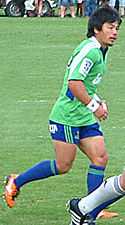Fumiaki Tanaka
 | |||
| Date of birth | 3 January 1985 | ||
|---|---|---|---|
| Place of birth | Kyoto, Japan | ||
| Height | 166 cm (5 ft 5 in) | ||
| Weight | 72 kg (11 st 5 lb) | ||
| School | Fushimi Technical High School | ||
| University | Kyoto Sangyo University | ||
| Rugby union career | |||
| Playing career | |||
| Position | Scrum-half | ||
| Professional / senior clubs | |||
| Years | Club / team | Caps | (points) |
| 2007–12 | Panasonic Wild Knights | 81 | (55) |
| Provincial/State sides | |||
| Years | Club / team | Caps | (points) |
| 2012– | Otago | 23 | (5) |
| correct as of 23 October 2013. | |||
| Super Rugby | |||
| Years | Club / team | Caps | (points) |
| 2013– | Highlanders | 14 | (5) |
| National team(s) | |||
| Years | Club / team | Caps | (points) |
| 2008– | Japan | 41 | (35) |
Fumiaki Tanaka (田中史朗, born 3 January 1985 in Kyoto, Japan) is a Japanese rugby union footballer. He plays as a scrum-half for Japan on international level and for the Panasonic Wild Knights, Otago and the Highlanders at domestic level.
Career
Tanaka was not seen as one of the top prospects in Japan whilst at University, but after joining the Panasonic Wild Knights in 2007 he played alongside former All Blacks fly half Tony Brown who was credited with helping him to develop immensely and Tanaka himself cites Brown as one of the most important influences on his career.[1] After Tanaka's first season in the Top League in 2007/08, he was named in the team of the season alongside Brown and also was named as newcomer of the year.[2]
After his first season in the Top League. Tanaka made his debut for Japan against the Arabian Gulf in May 2008 coming off the bench.[3] He soon became a regular member of the Japan side and made the squad for the 2011 Rugby World Cup as first choice scrum half and is currently considered one of Japan's best and most important players.[4] At domestic level, after being named in the Top League team of the season in his first year, he backed that up by being named in it again in 2008/09 and 2010/11.[5][6]
After performing well at the World Cup despite it being a disappointing tournament for Japan, along with hooker Shota Horie he was signed by Otago and reunited with Tony Brown, his former teammate at the Panasonic Wild Knights who was now his coach. He won plaudits for his performances with Otago with his coach Brown calling him a "world class player"[7] and the New Zealand Herald noted him as one of the most exciting players in the ITM Cup[8] and was regarded as a cult hero for Otago and seen as their standout player.[9][10]
Following his good performances with Otago, he became the first ethnic Japanese player to sign a Super Rugby contract when he was named in the Highlanders squad for the 2013 season.[11]
After signing for the Highlanders, there was significant international media interest in him as the first Japanese player to play Super Rugby. He was said to have most interview requests out of anybody in the Highlanders team and attracted more attention than many of the World Cup winners in the squad. Japanese TV channels NHK and WOWOW did documentaries on his time in New Zealand, he also received a segment on IRB Total Rugby and even made the pages of the New York Times.[12][13][14][15]
After initially being limited to mainly to substitute appearances behind All Blacks scrum half Aaron Smith, in Tanaka's second start in Super Rugby he was highly praised for his performance against the Blues which even drew praise from the IRB CEO Brett Gosper.[16][17][18][19]
In June 2013, Tanaka helped inspire Japan to their first ever win over Wales where he continued his run of form and was praised as one of the game's outstanding performers.[20][21][22]
Notes
At just 166 cm tall and weighing between 72 kg, Tanaka is one of the smallest professional rugby players in the world. He was the smallest player at the 2011 Rugby World Cup, and is understood to be the smallest player ever to have been involved in Super Rugby. Tanaka has commented that his size "is an advantage".[12]
Tanaka has a tradition of shaving his head before the first game of the rugby season.[23]
References
- ↑ "Rugby: Super break, big challenge".
- ↑ "個人表彰 2007-08".
- ↑ "Japan v Arabian Gulf at Osaka)".
- ↑ "STEADY EDDIE".
- ↑ "個人表彰 2008-09".
- ↑ "個人表彰 2010-11".
- ↑ "Brown sings Tanaka's praises".
- ↑ "Rugby: Five ITM Cup excitement machines".
- ↑ "Fumiaki Tanaka (Highlanders & Japan)".
- ↑ "Japanese Players Open a New Frontier: Super Rugby".
- ↑ "The First Samurai - Fumiaki Tanaka".
- ↑ 12.0 12.1 "Huge interest in tiny player".
- ↑ "Rugby: International media take shine to Tanaka".
- ↑ "Tanaka makes headlines with Highlanders debut".
- ↑ "Fumiaki Tanaka Total Rugby".
- ↑ "Fumiaki Tanaka earns plaudits".
- ↑ "Weepu stunned, Tanaka stunning".
- ↑ "OPINION: Tanaka blossoming down south".
- ↑ "Twitter / brettgosper".
- ↑ "Japan 23-8 Wales: No complaints for Robin McBryde's team after first Japan defeat".
- ↑ "Second Test: Joy for Japan as Wales wilt in Tokyo".
- ↑ "Robin McBryde bemoans wasteful Wales after latest calamity".
- ↑ "Fumiaki's haircut".
External links
- http://www.espnscrum.com/scrum/rugby/player/15874.html
- http://www.rugbyworldcup.com/home/teams/team=49/player=29893/index.html (Japanese)
| |||||||||||
| |||||||||||||||||||||||||||||||||||||||||